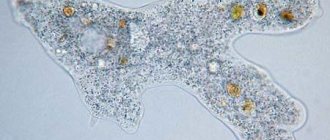Description
Synonyms (rus): NMDA receptor, NMDAR-autoimmune encephalitis
Synonyms (eng): NMDAR-associated autoimmune disorder
Biomaterial: serum/cerebrospinal fluid
Indicator(s): Antibodies to NDMAR
Method(s): Indirect immunofluorescence reaction
Container type and preanalytical features: Sterile container, WITHOUT additives, 60 ml; / Biochemical tube with coagulation activator, 6 ml (red or brown cap)
Antibodies to the NMDA (N-methyl-D-aspartate)-glutamate receptor belong to the family of “antineuronal antibodies” that react with the receptor apparatus of neurons, mediating interneuronal signal transmission and synaptic plasticity. They are the main marker of “classical” autoimmune encephalitis (AE), a disease that predominantly affects young women and adolescents. Encephalitis is often paraneoplastic in nature and is associated with teratoma of the ovaries and testicles. The disease debuts with behavioral disorders, then disturbances of consciousness and convulsions develop. In some cases, it is noted independently, without connection with the tumor. Detection of antibodies to NMDA in the cerebrospinal fluid is a more preferable approach to diagnosing autoimmune encephalitis.
In recent years, thanks to advances in neuroimmunology, a group of new neurological diseases has been identified, which are autoimmune encephalitis (encephalopathy). Caused by an autoimmune attack directed against various antigenic targets of the central nervous system (primarily glutamate, dopamine, GABA receptors, as well as potassium channels), they are characterized by a subacute onset, rapid progression or fluctuating course with alternating exacerbations and remissions, multifocal brain damage with a bizarre combination of irritation symptoms and loss of function, nonspecificity and paucity of findings during neuroimaging and routine examination of cerebrospinal fluid (CSF). In severe cases of the disease, patients often find themselves in critical condition, but with timely diagnosis and adequate therapy, even in severe cases, a complete recovery is possible. Unfortunately, such cases are often interpreted by practitioners as an unusual form of manifestation of mental pathology, infectious diseases, multiple sclerosis, and therefore the opportunity to radically intervene in the course of the disease and prevent an unfavorable outcome is lost.
One of the main representatives of this group of diseases is autoimmune encephalitis with antibodies to NMDA-type glutamate receptors (anti-NMDA receptor encephalitis, EAGR). It was first described by R. Vitaliani et al. [1] in 2005 in a patient with ovarian teratoma with acutely developed psychotic disorders, severe amnesia, episodes of confusion, disorientation and central hypoventilation. Only 2 years later, an antigen was identified that was a target for an autoimmune attack that causes such symptoms. It turned out to be the GluN1 subunit of the NMDA receptor, which is found in the highest concentration on hippocampal neurons [2]. Antibodies to NMDA receptors have high diagnostic specificity, their pathogenicity has been proven in neuronal cultures and in vivo
.
It is difficult to reliably judge the frequency of EAHR, but periodic publications of new clinical cases suggest that it is much more common than previously thought. Thus, after the first publications in 2005 and the identification of antigens in the NMDA receptor subunit in 2007, in the next 3 years, information was published on 417 cases of EAHR [3], which exceeded the frequency of cases of limbic encephalitis (200 cases over a 13-year period observations [4] and 500 for a 6-year period [5]). Until recently, however, the most common form of autoimmune encephalitis was considered to be limbic. A retrospective analysis showed that EAGR accounts for 1% of all cases of encephalitis [6], and in the UK the incidence of this disease reached 4% of the total number of cases of inflammatory brain damage [7]. The disease primarily affects young people (95% of patients are under 45 years of age, 37% are under 18 years of age).
An analysis of the literature showed that no cases of this disease have been described in Russia to date. We present a clinical case with laboratory confirmed autoimmune EAGR.
Clinical observation
A 28-year-old female patient was taken by ambulance to a psychiatric hospital. The psychiatrist on duty diagnosed an acute polymorphic disorder with symptoms of schizophrenia. From the life history: no heredity, has a higher education, worked as an economist in a bank.
From the presented medical documentation, it is known that during the 10 days before hospitalization, the patient experienced increased anxiety and drowsiness (slept about 15 hours a day). The patient complained of general weakness, malaise, and weakness, which she associated with the fact that she had not slept “for almost a week.” She subsequently admitted that she hears music and voices that keep her from falling asleep. She became agitated, aggressive, did not let her relatives home, shouted something, tried to hit them. According to those close to her, she spoke about voices and gave the impression of a person under someone’s influence. She shouted, “that we need to clean up,” turned on and off household appliances, started and did not finish the usual everyday actions (washing dishes, floors, wiping dust), rushed around the apartment, grasping at new things to do, repeating: “We must, we must...”. Periodically, she grabbed her head and screamed: “It’s scary, scary...”, “Get him out of my head...”, “Hold, hold me... it’s me in my head...”, “Why are you taking my energy...”. At the same time, she was oriented to the place and her own personality, and recognized relatives. Periodically she screamed, blamed her mother, friend, sister, and then, on the contrary, said that they were the smartest, kindest, most beloved, she wrung her hands, grabbed her head, was aggressive, and therefore was forcibly hospitalized by the ambulance team in a psychiatric hospital .
Upon admission, severe psychomotor agitation was noted. Formally, the patient was conscious, but not available for productive contact, her facial expression was confused, “fascinated.” She either said that she was in a hospital in Moscow, or claimed that she was in Finland. She called herself by a different name, said that she was 50 years old, while leaving many questions unanswered, she giggled, periodically became embittered and shouted: “Leave me alone.” She admitted that she feels someone’s influence on her, and constantly hears music and “something else” in her head. She often uttered separate words that were not related in meaning. Negativism and resistance to examination were noted. In general, the patient looked drowsy, but upon persistent questioning she became excited, actively waved her arms, and cursed angrily. From the moment of admission, risperidone (9 mg/day) and phenazepam (2 mg/day) were prescribed.
On the 4th day of hospital stay, disorganized thinking and behavior, episodes of agitation and aggression were noted; the patient was verbose, but most of the words and statements were not to the point, she began to refuse food and drink, and therefore haloperidol (4 mg/day) was added to therapy. The next day, drowsiness and lethargy increased, and she could not get out of bed. The answers were monosyllabic, unrelated to the essence of the questions. Feeding and drinking were possible only under compulsion. Due to the appearance of leukocytosis in the blood (12.3·109/l), she was examined by a therapist; exacerbation of chronic bronchitis was suspected, and therefore ceftriaxone (2.0 IM/day) was added to treatment. On the same day, instability of blood pressure with a tendency to hypertension up to 160/100 mm Hg, tachycardia up to 120 beats per minute, normal body temperature, and the absence of focal neurological symptoms were noted.
The next day, the patient became unavailable for contact, did not follow instructions, her speech was slurred, she constantly muttered something, and made stereotypical movements with her hands; When trying to feed, she actively resisted. Aminazine 2.0 IM was prescribed. By decision of the council, with a diagnosis of “catatonic stupor with refusal to eat,” she was transferred to a psychiatric hospital with an intensive care unit.
Upon admission, the face is mask-like, the gaze is fixed, directed forward. When contacted, the gaze does not fixate; there is an expression of fear and suffering on the face; he moans continuously. Doesn't answer questions, doesn't follow instructions. Passive negativism: when trying to examine, he squeezes his eyelids harder. Oral dyskinesia was noted for the first time: the patient stereotypically protruded her lower jaw with biting her lips. Dyskinesia of the feet and hands and occasional dystonic movements of the torso were also observed.
On the 18th day from the onset of the disease, the patient developed a generalized convulsive attack, after which spontaneous breathing was absent, blood pressure and pulse were not determined. During resuscitation measures, cardiac activity was restored, the patient was intubated and transferred to artificial pulmonary ventilation (ALV). For the first time, hyperthermia up to 38.8 °C was detected. Treatment: dopamine solution via infusion pump, ceftriaxone 4 mg/day intravenously, gentamicin 240 mg/day intravenously, biperiden solution 0.5% 1 ml intravenously, saline solution with a total volume of 1200 ml/day.
The next day, by decision of a council with the participation of a resuscitator, psychiatrist, neurologist, neurosurgeon, and infectious disease specialist, she was transferred in serious condition to the intensive care unit of a multidisciplinary hospital with a diagnosis of “space-occupying lesion of the left hemisphere of the brain.” Coma of unknown etiology. Condition after a full-blown convulsive attack and clinical death, resuscitation measures. Ventilation Acute psychotic disorder. Neuroleptic syndrome." Upon admission to the intensive care unit: severe condition, coma 1 (against the background of drug sedation), pupils are symmetrical, eyeballs are fixed in the midline, oromandibular dyskinesia with tongue protrusion, spontaneous non-purposeful movements in the upper extremities, tendon reflexes are reduced without a clear difference in sides, symptom Babinsky on both sides. There is no meningeal syndrome. In a clinical blood test, leukocytosis is up to 17.3·109/l. A biochemical blood test revealed an increase in the level of urea, glucose, transaminases, and creatine phosphokinase to 1889 U/L. Under K.T. With contrast enhancement, no evidence of focal brain damage was obtained. Carbamazepine was started (200 mg twice a day).
The next day, the condition did not change significantly: hyperthermia 38.6 °C, mechanical ventilation, drug sedation (sodium thiopental). A lumbar puncture was performed. The CSF revealed pleocytosis (112/3, lymph. 63%, n. 37%) with normal protein and glucose levels. Considering the onset of the disease with cognitive and psychotic impairments, associated motor disorders in the form of oromandibular dyskinesia and dyskinesias in the limbs, an epileptic seizure, moderate lymphocytic pleocytosis in the CSF, it was suggested that autoimmune encephalitis (possibly associated with antibodies to NMDA receptors) or viral (possibly , herpetic) nature. A study of CSF using PCR for herpes viruses, a blood test for antibodies to NMDA receptors, and an MRI of the brain are recommended. Treatment with methylprednisolone (1000 mg/day IV) and acyclovir (2 g/day until PCR results are available) was started.
MRI of the brain showed an increase in signal intensity in DWI, T2, FLAIR modes from the mediobasal temporal regions, as well as the lower parts of the caudate nuclei (see figure).
MRI images in FLAIR mode. Increased signal intensity from the mediobasal regions of the temporal lobes.
Over the next 3 days, the condition remained serious. Hyperthermia persisted to 38.6 °C. Negative PCR results for herpes viruses were obtained. The acyclovir infusion was discontinued. Ultrasound examination of the pelvic organs revealed a mature teratoma of the right ovary. On the 25th day from the onset of the disease, a positive blood test for antibodies to NMDA receptors was obtained (total titer of IgG, A, M - 1:160, with the norm being up to 1:10), which made it possible to diagnose EAGR against the background of teratoma of the right ovary. It was decided to extend the administration of methylprednisolone 1 g/day to 7 days, after which to consider escalation of immunosuppressive therapy. The next day, the condition worsened sharply, the degree of depression of consciousness increased, the temperature reached 40 °C, and systemic pressure dropped to 60/40 mm Hg. and required vasopressor support. On the 27th day from the onset of the disease, death occurred due to symptoms of acute heart failure.
The literature [8, 9] contains data on more than 500 cases of EAHR, the analysis of which reveals characteristic clinical symptoms of both the acute and recovery phases of the disease. In 70% of cases, there is a prodromal period with symptoms of general weakness, headache, dyspeptic disorders (nausea, vomiting, diarrhea), fever, and in some cases with symptoms of upper respiratory tract infection.
Typically, severe psychotic disorders appear within the first 2 weeks, which often leads to hospitalization in a psychiatric hospital with suspected onset of schizophrenia. The most common symptoms of mental debut are anxiety, fear, insomnia, manic state, delusional disorders (a paranoid syndrome with motives of newly emerged hyper-religiosity has been described), hallucinations of various modalities [10]. Most patients have mnestic disorders, as well as speech disorders with the development of echolalia and a rapid outcome to mutism [11].
Increasing cognitive, psychotic and behavioral symptoms in almost 90% of cases are accompanied by extrapyramidal disorders - orofacial dyskinesia, often with a characteristic movement of the tongue (like a “snake tongue”), chorea or stereotypies, less often dystonia and rigidity in the limbs, the development of oculogyric crises and opisthotonus. Considering the onset of the disease with psychotic symptoms, in almost 100% of cases these patients are prescribed neuroleptics, which often leads to an erroneous judgment about the connection between motor manifestations and catatonia with complications of neuroleptic therapy.
As the disease progresses, the patient stops responding to external stimuli, and episodes of psychomotor agitation may give way to catatonia. An increase in body temperature in combination with catatonia may suggest febrile schizophrenia or neuroleptic malignant syndrome, which complicates the diagnostic search and delays the time of diagnosis. Indeed, antipsychotics can aggravate the patient’s condition and contribute to a more rapid progression of the disease, however, extrapyramidal symptoms develop even without their use.
In addition to hyperthermia, patients with EAHR may have other autonomic disorders: tachy- or bradycardia, arterial hyper- or hypotension, hypersalivation, urinary incontinence, etc. Sharp fluctuations from tachy- to bradycardia, from hypo- to hypertension, from hyper- to hypothermia (vegetative instability). Respiratory and cardiac disorders may require constant infusion of vasotonics and the patient being placed on mechanical ventilation [10]. Most often, respiratory failure manifests itself when consciousness is depressed to the point of coma, but respiratory disorders can develop even with relatively preserved consciousness.
The phenomenon of dissociative anesthesia, more characteristic of the action of NMDA receptor antagonists (ketamine, phencyclidine), is often noted - in the complete absence of contact and reaction to painful stimuli, the patient formally remains conscious - lies with his eyes open and his gaze fixed at one point. Epileptic seizures, which develop in almost 85% of patients, often remain unrecognized due to concomitant extrapyramidal disorders, psychomotor agitation, or the need to maintain drug sedation. Attacks can be both generalized and focal, often accompanied by worsening autonomic disorders. In some cases, they first appear upon recovery from drug sedation [11].
In the literature there are descriptions of a “mild” (monosymptomatic) course of EAGR with long-term dominance of one of the symptoms of the disease. Thus, cases with isolated psychotic symptoms, epileptic seizures, dystonia or other neurological symptoms have been described, but a similar course is observed in less than 5% of patients. Seizures, as well as extrapyramidal disorders at onset, more often develop in children. Mostly monosymptoms are temporary and subsequently the disease acquires a detailed clinical picture. By 3-4 weeks, almost 90% of patients develop a more or less typical picture, including most of the following main groups of syndromes: cognitive, behavioral, extrapyramidal disorders, autonomic instability and hypoventilation, epileptic seizures, cerebellar, pyramidal disorders. For example, J. Dalmau et al. [11] described the development of an isolated manic syndrome in a 19-year-old man, which after 3 weeks was joined by mnestic disturbances, as well as the phenomenon of orofacial dyskinesia.
Neuroimaging methods usually do not reveal specific changes, but sometimes MRI in T2, FLAIR or DWI modes shows a hyperintense signal from the hippocampus and medial temporal lobes (the picture may resemble limbic encephalitis), cortical parts, cerebellum, basal parts of the frontal lobes, subcortical or brainstem structures, less often in the spinal cord [2]. In most cases, these changes are moderate, both transient and persistent, but, as a rule, do not correlate with the clinical picture and severity of the condition [10, 12]. Earlier studies identified moderate cortical atrophy in patients with refractory epileptic seizures, poor recovery, or death, but now, with more aggressive immunoactive therapy, cases with poor recovery have become rare and there is practically no data on the formation of secondary atrophic changes in the cortex [2, 13]. Positron emission computed tomography or single photon emission computed tomography studies demonstrate variable changes in the cortical and subcortical regions of the brain, but sometimes, in the early stages of the disease, they may be absent [13–16].
EEG data are variable and depend on the stage of the disease. Periodic acute or peak wave activity may be observed, which, with the rapid progression of cognitive, behavioral and motor disorders, sometimes leads to an erroneous diagnosis of Creutzfeldt-Jakob disease [11]. However, in most cases, EEG reveals nonspecific changes in the form of disorganization and slowing of activity [17].
In 80% of patients, moderate lymphocytic pleocytosis and a slight increase in protein levels are detected in the CSF; in 60%, oligoclonal antibodies are detected [11]. Changes in the CSF may persist throughout the entire period of the disease, as well as during the recovery period, while their degree does not correlate with the severity of the patient’s condition and may not change depending on the effectiveness of the therapy.
The most specific diagnostic criterion is an increase in the titer of antibodies to NMDA receptors in the blood and CSF [3, 11, 18]. The specificity of this diagnostic method is about 80%, which leaves room for false positive results. To avoid overdiagnosis, the clinician should always evaluate laboratory data in the clinical context. In addition, it makes sense to conduct antibody studies in both blood and CSF, and also repeat them over time. Determining the level of antibodies in the CSF does not have significant advantages over the determination in the blood, but at the same time, cases of so-called seronegative encephalitis have been described in which the test in the blood was negative, and in the CSF - positive. False-negative results in the blood were noted in the acute period of the disease, as well as after immunosuppressive therapy (primarily plasmapheresis and intravenous immunoglobulin). In such cases, detection of antibodies is possible only in the CSF [6, 17], but reverse dissociation can also be observed [19].
Considering that EAHR was initially described in women with ovarian teratoma, for some time this form of CNS damage was considered exclusively paraneoplastic. As new cases were described, as well as in connection with the introduction into clinical practice of detecting antibodies to NMDA receptors as a routine screening test, it became clear that the process is often idiopathic. Most often, idiopathic EAHR occurs in children and adolescents, but as age increases, the proportion of paraneoplastic cases increases.
Most often, this type of encephalitis is combined with ovarian teratoma, which explains the high incidence in women (sex ratio 4:1) [11]. Sex differences in incidence are less significant under 12 and over 45 years of age. The development of EAGR is also possible against the background of other tumors (no more than 2% of cases). Cases of its development in lymphoma, neuroblastoma, and small cell lung cancer have been described [10, 20, 21]. However, if in the case of teratoma the cause-and-effect relationship between the two pathological processes is beyond doubt (NMDA receptors were identified when studying teratoma tissue), when encephalitis is combined with other tumors, the nature of the relationship requires further study. The incidence of tumor detection depends on age and gender: in children it is 0-5%, in women over 18 years of age - 58% (usually ovarian teratoma), in people over 45 years of age - 23% (usually carcinoma).
Detection of teratoma in patients with EAGR has both diagnostic and therapeutic significance: tumor removal is the most important condition for resolving the pathological process. Although the teratoma itself may not be malignant, its removal in both the subacute and recovery periods can lead to significant clinical improvement and a reduced risk of relapse [10, 22]. It has been noted that tumor-associated encephalitis is characterized by a more severe course, often accompanied by profound depression of consciousness, but at the same time has a better response to immunotropic therapy [10, 11, 17]. Thus, all female patients with suspected autoimmune encephalitis should be screened for the presence of teratoma (MRI, CT, pelvic ultrasound). Determining the concentration of currently available tumor markers (CA125, β-HGG, α-fetoprotein or testosterone) in some patients gives a negative result even with a detected tumor, so the diagnostic value of these tests remains unclear.
Considering that at the onset of the disease it is difficult to differentiate EAHR from viral or other infectious processes, in most of the described cases screening for the presence of pathogens was carried out. Thus, in addition to antibodies to NMDA receptors, patients had positive serological reactions to mycoplasma (more often in children); There are publications about the combination with infection with herpes simplex and influenza viruses [23, 24]. The identification of concomitant inflammatory processes is understandable, given the involvement of immune mechanisms in the development of autoimmune encephalitis: infectious antigens can lead to the launch of an autoimmune reaction. Apparently, for the same reason, the development of EAHR can occur after vaccination. A particularly close connection has been identified between EAHR and herpetic infection. A test for antibodies to NMDA receptors is indicated for recurrence of symptoms (for example, the appearance of choreoathetosis or mental disorders) several weeks after suffering herpetic encephalitis. In some patients with antibodies to NMDA receptors, other autoantibodies are detected - markers of “competing” autoimmune diseases (antinuclear, antibodies to thyroid peroxidase and thyroglobulin), which emphasizes the importance of assessing serological data in a clinical context [17, 25].
Approximately 70-75% of patients with EAHR, with timely initiation of therapy, experience complete or almost complete recovery. In other cases, severe neurological, including cognitive, deficits develop or death occurs. In some series of observations, its frequency reached 25% [11].
Treatment is based on various methods of immunosuppressive therapy, as well as identification and removal of the teratoma. The first line of drugs is corticosteroids (usually pulse therapy with methylprednisolone at a dose of 1 g/day), intravenous immunoglobulin and/or plasmapheresis. Since the time frame for detecting antibodies to NMDA receptors is about 10 days, the rate of progression and the risk of death force a decision to prescribe a trial of immunotropic therapy from the moment of suspicion of this disease (for example, corticosteroids according to the pulse therapy regimen or intravenous immunoglobulin, 0.4 g /kg/day for 5 days). After receiving positive test results for antibodies to NMDA receptors and taking into account the results of trial therapy, it is necessary to consider prescribing a second line of therapy (monoclonal antibody drug rituximab or cytostatic cyclophosphamide).
When encephalitis is combined with ovarian teratoma, the effectiveness of these treatment methods reaches 80%, and in the absence of teratoma - 48%. In this regard, there is an opinion [7, 10, 11, 26-28] that in severe cases, in cases where the tumor cannot be detected, first-line drugs should be prescribed in combination with second-line immunosuppressants (rituximab, cyclophosphamide).
Teratoma removal is an important element of therapy; in some cases, improvement is achieved literally within a few hours after surgery. However, in some patients, surgery is not possible due to the severity of the condition. According to a systematic review [29], teratoma was most often removed in the period from 39 to 72 days, depending on the age and type of tumor. The optimal (recommended) timing of removal is within 4-8 weeks from the onset of the clinical picture.
There are no substantiated recommendations for the management of patients with EAHR in intensive care units. Given that the symptoms of encephalitis largely resemble those of an overdose of NMDA receptor antagonists, the use of drugs with similar effects (for example, ketamine) should be avoided. W. Splinter and N. Eipe [30] described the development of arterial hypotension with the administration of propofol, however, when repeated administration after several weeks, there were no adverse events, and it was well tolerated.
Recovery of patients after EAHR can be slow and lasts from several months to 2-3 years. Impulsivity, disinhibition, inappropriate behavior, hyperphagia, hypersexuality, hypersomnia, in some cases, full-blown Kluver-Bucy and Klein-Levin syndromes require long-term rehabilitation. In approximately 20-25% of cases, a relapsing course is observed with varying intervals between exacerbations and variable residual symptoms during “cold” periods [7, 11]. Recovery can also occur spontaneously, but, according to available data [13], survival, prognosis of recovery and risk of relapse depend on the timeliness and activity of therapy.
In the case we presented, the disease manifested itself with classic symptoms: after a week-long prodromal period, the patient acutely developed agitation, confusion, delusional disorders, hallucinations, followed by the addition of motor disorders (including oromandibular dyskinesia, stereotypies), catatonia, epileptic seizure, severe autonomic disorders (hypoventilation , hyperthermia, blood pressure fluctuations, tachycardia).
The diagnosis was confirmed by paraclinical examination data - moderate lymphocytic pleocytosis, increased signal from the mediobasal parts of the temporal lobes according to MRI, as well as a mature teratoma of the right ovary identified by ultrasound. A reliable diagnosis of EAHR was made possible by the detection of a high titer of antibodies to NMDA receptors in the blood (1:160).
Among the features of this observation, it should be noted the rapid rate of progression (less than 1 month from the prodromal phase to death), pronounced autonomic instability, against the background of which an episode of clinical death occurred after a convulsive attack, as well as the lack of clinical effect of methylprednisolone, which may be due to the relatively late appointment (21st day from the beginning of the prodromal phase).
In conclusion, it should be emphasized that timely diagnosis of EAHR requires the vigilance of doctors of all specialties (primarily neurologists, psychiatrists, gynecologists, resuscitators), who may encounter this highly dramatic, but treatable disease. EAHR should be suspected in all persons under 50 years of age, especially in children and adolescents with rapidly developing psychotic, cognitive and behavioral disorders, early onset of extrapyramidal disorders (dyskinesia, stereotypies, rigidity), catatonia, epileptic seizures, autonomic symptoms (hyperthermia, hypoventilation, hypertension, arrhythmia, etc.). Signs confirming the diagnosis may include lymphocytic pleocytosis in the CSF with the presence of oligoclonal antibodies and a possible moderate increase in protein levels; slow-wave disorganized activity on the EEG, as well as MRI changes in the form of signal hyperintensity in FLAIR, T2 and DWI modes with possible accumulation of contrast agent. High pleocytosis and a significant increase in protein levels in the CSF, as well as more severe changes according to MRI (especially with the formation of areas of necrosis or the presence of a mass effect) exclude the diagnosis of EAGR and require a search for alternative causes (in particular, viral encephalitis). Criteria for diagnosing encephalitis have recently been published [31] (see table). All patients with suspected autoimmune encephalitis should be tested for antibodies to NMDA receptors in the blood and CSF, as well as screened for the presence of ovarian teratoma. Even if the tumor is not detected at the time of development of encephalitis, screening should be repeated for at least 2 years.
Criteria for diagnosing EAHR Note. * - in the presence of teratoma, three of the six groups of symptoms are sufficient; ** - antibody testing should be carried out not only in the blood, but also in the CSF.
There is no conflict of interest.
Interpretation
A negative result of detecting antibodies to the NMDA receptor in the cerebrospinal fluid significantly reduces the clinical likelihood of autoimmune encephalitis. Clinical manifestations of NMDA encephalitis include symptoms of agitated behavior, paranoia, psychosis, memory and speech impairment, and seizures. Detection of antibodies in cerebrospinal fluid is more sensitive than serum testing. Sensitivity and specificity rates are close to 100%. If characteristic symptoms of the disease are present and the result is negative for the presence of NMDA antibodies, testing for antibodies to voltage-gated potassium channels (VGKC), in particular antibodies to LGI-1 and CASPR, may be recommended. Antibody titers in cerebrospinal fluid correlate better with disease relapses than in serum. In addition, patients with a favorable outcome have a faster and greater decline in cerebrospinal fluid antibody levels than patients with an unfavorable outcome.
Antibodies to NMDA receptor (autoimmune encephalitis), IgG
Antibodies to NMDA receptors are specific proteins produced against NMDA receptors in the nervous system. These antibodies are the cause of autoimmune encephalitis.
Synonyms Russian
Anti-NMDAR, antibodies to N-methyl-D-aspartate receptors.
English synonyms
NMDA-receptor antibodies, anti-NMDAR, N-methyl-D-aspartate receptor antibodies.
Research method
Indirect immunofluorescence reaction.
What biomaterial can be used for research?
Venous blood.
How to properly prepare for research?
- Do not smoke for 30 minutes before the test.
General information about the study.
NMDA receptors are located on the surface of neurons in the central nervous system. Excitation and inhibition of these receptors underlies the mechanisms of memory, learning and consciousness.
The production of specific antibodies to NR1-NR2 by heteromers of NMDA receptors causes a reversible decrease in their number, disruption of their function and the development of symptoms of autoimmune encephalitis.
NMDAR encephalitis is the most common form of autoimmune encephalitis and most often presents as a paraneoplastic syndrome. Diagnosed in young women and children, it is associated with neoplasms, most often with ovarian teratoma.
Symptoms are nonspecific, characteristic of psychopathological conditions: depression, delirium, sound hallucinations. As the disease progresses, neurological symptoms may appear: memory loss, involuntary movements in various muscle groups, disruption of the autonomic nervous system, including the development of unstable hemodynamics, and respiratory failure.
Patients are often hospitalized in psychiatric, infectious diseases hospitals, and neurological departments with suspected organic pathology of the brain.
Diagnosis of this type of encephalitis is quite difficult. The disease is not characterized by specific changes that can be detected by MRI or PET-CT of the brain. When examining the cerebrospinal fluid, the changes are nonspecific.
A reliable diagnostic test is the determination of antibodies to NMDA receptors in blood serum and cerebrospinal fluid. For this study, an enzyme-linked immunosorbent assay is used to determine native antibodies to NMDA receptors in biological fluids. This analysis has high sensitivity and specificity, allows for cancer screening, verification of the diagnosis and initiation of early etiotropic therapy.
Patients with early initiation of antitumor immunotherapy have a better prognosis for complete restoration of nervous system function.
What is the research used for?
- To determine the cause of a nervous system disease.
- For differential diagnosis of encephalitis.
When is the study scheduled?
- When the genesis of psychopathological and neurological symptoms is unclear.
- With the simultaneous presence of psychiatric and neurological symptoms, especially in young patients.
- For symptoms of encephalitis in patients with a family history of cancer.
What do the results mean?
Reference values
Titer
Reasons for the increased result:
- autoimmune NMDAR encephalitis.
Reasons for the lower result:
- absence of disease.
Who orders the study?
Neurologist, oncologist, infectious disease specialist, psychiatrist.
Literature
1) NMDAR encephalitis: which specimens, and the value of values. Andrew McKeon and Vanda A Lennon. Lancet Neurology, The, 2014-02-01, Volume 13, Issue 2, Pages 133-135, Copyright © 2014 Elsevier Ltd.
2) The Importance of Keeping in Mind the Diagnosis of N -Methyl-D-Aspartate Receptor Encephalitis. Michael S. Zandi, Belinda R. Lennox and Angela Vincent. Biological Psychiatry, 2016-08-15, Volume 80, Issue 4, Pages e15-e15, Copyright © 2016 Society of Biological PsychiatryVolume 7, Issue 12, December 2008, Pages 1091-1098 LN.
3) Cellular and Synaptic Mechanisms of Anti-NMDA Receptor Encephalitis. Ethan G. Hughes, Xiaoyu Peng, Amy J. Gleichman, Meizan Lai, Lei Zhou, Ryan Tsou, Thomas D.










